|
Printables |
PowerPoints |
Online exercises |
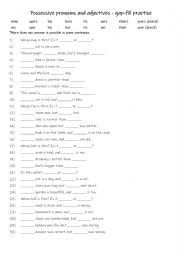
|
Possessive pronouns and adjectives - gap-fill practise
Students read the sentences and questions and complete it with the correct possessive pronoun or adjective. Answers on page 2.
Level: elementary
Age: 8-100
Type:
Downloads: 123
|
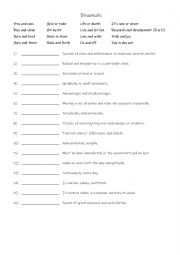
|
Binomials - common pairs of words 1b
Students read the definitions and match them with the correct pair of words.These pairs are often used for their rhythmic and memorable qualities, making the language more engaging and easier to remember.In English grammar, binomials are expressions where two words are joined by a conjunction (usually "and" or "or") to form a fixed phrase. These wo...
Level: intermediate
Age: 12-100
Type: worksheet
Downloads: 117
|
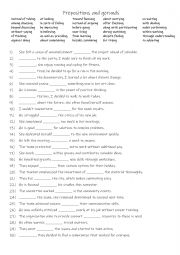
|
B1-B2 Prepositions + gerunds 2
Many English expressions rely on specific prepositions and gerunds. Mastering these can improve fluency and make language sound more natural. Using the correct prepositions and gerunds can elevate students writing style, making it more varied and engaging. First, students need to familiarise themselves with the 30 gerunds and prepositions to check ...
Level: intermediate
Age: 9-100
Type:
Downloads: 110
|
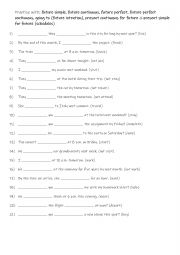
|
B1-B2 Future Simple, Future Continuous, Future Perfect, Future Perfect Continuous, Going to (Future Intention), Present Continuous for Future, Present Simple for Future (Schedules) 1
Learning the various future tenses in English (such as Future Simple, Future Continuous, Future Perfect, Future Perfect Continuous, "Going to," Present Continuous, and Present Simple) is important because each tense conveys a different aspect of future actions. These tenses help students to express predictions, plans, ongoing actions, completed act...
Level: intermediate
Age: 9-100
Type:
Downloads: 106
|
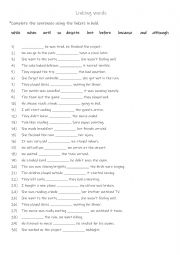
|
A2+-B1+ 10 linking words students should know at this level
Learning to use linkers encourages critical thinking as you have to decide the best way to connect ideas, which helps in organising your thoughts and arguments more effectively. Mastering these linkers provides versatility in writing, enabling you to craft a wide variety of sentence types, from simple to compound-complex, which can be tailored to d...
Level: intermediate
Age: 10-100
Type:
Downloads: 107
|
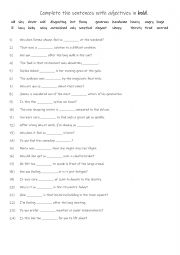
|
A2-B1 24 adjectives to describe:feelings and personal traits
Students familiarise themselves with 24 adjectives and their meanings.Then they read the sentences to see which adjective is suitable to complete the gap-fill. Answers on page 2.
Level: intermediate
Age: 8-100
Type:
Downloads: 120
|
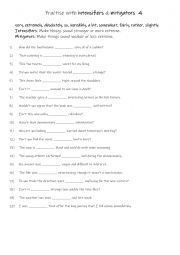
|
B1-B2 Practise with intensifiers & mitigators 4
First, students need to familiarise themselves with the intensifiers & mitigators and their use. Then they read the sentences to work out which one is needed to complete the gap-fill. Each intensifier & mitigator is used 2 times! Obviously, there are more than 1 possible answer! Possible answers on page 2
Level: intermediate
Age: 11-100
Type:
Downloads: 124
|
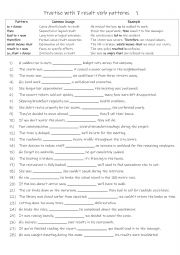
|
B1-B2 Practise with 7 result verb patterns 1
Students should learn these patterns because they are essential for expressing cause-and-effect relationships, which are fundamental in both spoken and written communication. Mastering these structures helps students connect ideas logically and cohesively, whether they are explaining events, giving reasons, or drawing conclusions. Additionally, und...
Level: intermediate
Age: 9-100
Type:
Downloads: 104
|
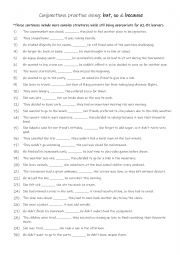
|
A2-B1 Conjunctions practise using: but, so & because
These sentences include more complex structures while still being appropriate for A2-B1 learners. Students read the sentences and complete the gap-fill with the correct conjunction. Answers on page 2.
Level: intermediate
Age: 10-100
Type:
Downloads: 105
|
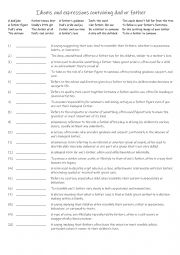
|
Idioms and expressions containing dad or father B1+-C1 (1)
Learning phrases about fathers improves cultural literacy, communication, and creativity in language use. Expressions like "Like father, like son" and "The apple doesn�t fall far from the tree" help students understand societal views on family and inheritance. Figurative phrases like "Dad�s taxi service" or "A father�s love" add depth and emotional...
Level: intermediate
Age: 10-100
Type:
Downloads: 110
|
|
|
|
|












